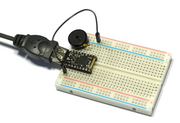
Pico FET Output
Introduction
The Espruino Pico has a FET built in, which can supply a 1.5A (or even 5A pulsed) 5v output.
While this is usually used to power Espruino from a battery, when the Pico is running from USB it is not needed and can be controlled from the Pico itself.
As an example, we're going to connect the piezo speaker up - if you compare the output to that of the Pico Piano it should be louder. However the output is capable of much more - for example driving bigger speakers, light bulbs, or relays.
You'll Need
- An Espruino Pico
- A Speaker
- Breadboard
- A 470 Ohm resistor (yellow, purple, brown)
- A Jumper Wire
Wiring Up
Because the FET can be used to charge a battery from USB (and this could be dangerous with LiPo batteries) the FET is disabled by default. To enable it, you need to short out the FET/B0 jumper on the back of the board.
You can do that just by scribbling over it with an HB pencil:

Now:
- Take the Pico board and place it in the breadboard so that the USB connector sticks out to the left.
- Attach the jumper wire from the bottom left pin, to the second from top row marked '-'
- Insert the Piezo speaker so one pin is in the row rising from the top-left pin (
Bat) of the Pico, and the other is in the second from top row of the breadboard (GND). - Insert the resistor across the Piezo speaker (so between
BatandGNDagain) - as the FET only pulls the voltage up to 5v, you need the resistor to pull it back down to 0v and to make a sound.
If you wanted to power something else you'd just connect it straight between Bat and GND - there's no need for the resistor.
Software
Now we're all wired up, the code to drive the output is simple. As shown here, to turn the output off you'll need to make sure the pin B0 is an input (or is in open drain mode) first.
As we don't want to damage the piezo we're only going to output a square wave, but you could connect some other device and use the other bits of example code to turn it fully (or half) on.
pinMode(B0, "af_opendrain");
analogWrite(B0, 0.5, {freq:3000}); // Start the sound
// Now save our ears
setTimeout(function() {
pinMode(B0, "input");
}, 1000);
or something a bit more tuneful:
var pitches = {
'A':440.00, 'B':493.88, 'C':523.25, 'D':587.33,
'E':659.26, 'F':698.46, 'G':783.99, 'a':880
};
var tune = "E BCD CBA ACE DCB CD E C A A D Fa GFE CE DCB BCD E C A A ";
var pos=0;
setInterval(function() {
var ch = tune[pos];
if (ch !== undefined) pos++; else pos=0;
if (ch in pitches) {
pinMode(B0, "af_opendrain");
analogWrite(B0, 0.5, {freq:pitches[ch]});
} else pinMode(B0, "input");
}, 100);
This page is auto-generated from GitHub. If you see any mistakes or have suggestions, please let us know.